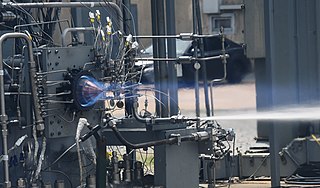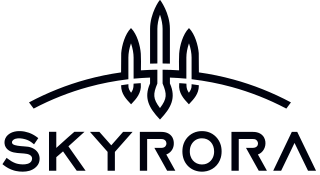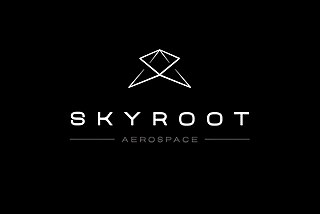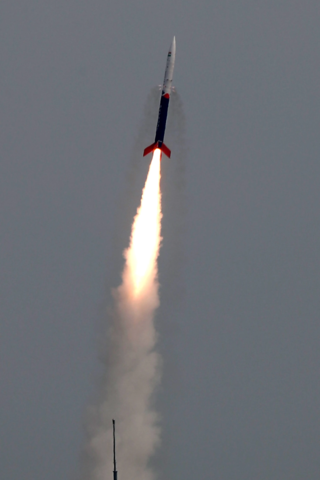Related Research Articles

The aerospike engine is a type of rocket engine that maintains its aerodynamic efficiency across a wide range of altitudes. It belongs to the class of altitude compensating nozzle engines. Aerospike engines were proposed for many single-stage-to-orbit (SSTO) designs. They were a contender for the Space Shuttle main engine. However, as of 2023 no such engine was in commercial production, although some large-scale aerospikes were in testing phases.

The Brazilian Space Agency is the civilian authority in Brazil responsible for the country's space program. It operates a spaceport at Alcântara, and a rocket launch site at Barreira do Inferno. It is the largest and most prominent space agency in Latin America.

The F-1, commonly known as Rocketdyne F-1, is a rocket engine developed by Rocketdyne. This engine uses a gas-generator cycle developed in the United States in the late 1950s and was used in the Saturn V rocket in the 1960s and early 1970s. Five F-1 engines were used in the S-IC first stage of each Saturn V, which served as the main launch vehicle of the Apollo program. The F-1 remains the most powerful single combustion chamber liquid-propellant rocket engine ever developed.

XCOR Aerospace was an American private spaceflight and rocket engine development company based at the Mojave Air and Space Port in Mojave, California, Midland International Air and Spaceport in Midland, Texas and the Amsterdam area, the Netherlands. XCOR was formed in 1999 by former members of the Rotary Rocket rocket engine development team, and ceased operations in 2017.

Masten Space Systems was an aerospace manufacturer startup company in Mojave, California that was developing a line of vertical takeoff, vertical landing (VTVL) rockets, initially for uncrewed research sub-orbital spaceflights and eventually intended to support robotic orbital spaceflight launches.

The Launch Vehicle Mark-3 or LVM3 is a three-stage medium-lift launch vehicle developed by the Indian Space Research Organisation (ISRO). Primarily designed to launch communication satellites into geostationary orbit, it is also due to launch crewed missions under the Indian Human Spaceflight Programme. LVM3 has a higher payload capacity than its predecessor, GSLV.

The Vikas is a family of hypergolic liquid fuelled rocket engines conceptualized and designed by the Liquid Propulsion Systems Centre in the 1970s. The design was based on the licensed version of the Viking engine with the chemical pressurisation system. The early production Vikas engines used some imported French components which were later replaced by domestically produced equivalents. It is used in the Polar Satellite Launch Vehicle (PSLV), Geosynchronous Satellite Launch Vehicle (GSLV) and LVM3 for space launch use.

Reusable Launch Vehicle–Technology Demonstration Programme is a series of technology demonstration missions that has been conceived by the Indian Space Research Organisation (ISRO) as a first step towards realising a Two Stage To Orbit (TSTO) re-usable launch vehicle, in which the second stage is a spaceplane.

The CE-20 is a cryogenic rocket engine developed by the Liquid Propulsion Systems Centre (LPSC), a subsidiary of the Indian Space Research Organisation (ISRO). It has been developed to power the upper stage of the LVM3. It is the first Indian cryogenic engine to feature a gas-generator cycle. The high thrust cryogenic engine is the most powerful upper stage cryogenic engine in operational service.
The RD-120 is a liquid upper stage rocket engine burning RG-1 and LOX in an oxidizer rich staged combustion cycle with an O/F ratio of 2.6. It is used in the second stage of the Zenit family of launch vehicles. It has a single, fixed combustion chamber and thus on the Zenit it is paired with the RD-8 vernier engine. The engine was developed from 1976 to 1985 by NPO Energomash with V.P. Radovsky leading the development. It is manufactured by, among others, Yuzhmash in Ukraine.

The Blue Engine 4 (BE-4) is an oxygen-rich liquefied-methane-fueled staged-combustion rocket engine produced by Blue Origin. The BE-4 was developed with private and public funding. The engine has been designed to produce 2.4 meganewtons (550,000 lbf) of thrust at sea level.

A rotating detonation engine (RDE) uses a form of pressure gain combustion, where one or more detonations continuously travel around an annular channel. Computational simulations and experimental results have shown that the RDE has potential in transport and other applications.

Skyrora Ltd is a British private space company based in Edinburgh, Scotland, since 2017.

Skyroot Aerospace Private Limited is an Indian private aerospace manufacturer and commercial launch service provider headquartered in Hyderabad, Telangana. The company was founded by former engineers and scientists from ISRO. It aims to develop and launch its own series of small-lift launch vehicles especially crafted for the small satellite market.

BluShift Aerospace is an employee-owned American aerospace firm based in Brunswick, Maine. Targeting the growing smallsat and cubesat launch markets, bluShift is developing suborbital sounding rockets and small-lift orbital rockets which will be launched from a proposed new spaceport in Maine. The company has received primary funding from NASAs SBIR grant program, the National Science Foundations I-Corps grant program, the Maine Technology Institute, and the Maine Space Grant Consortium. The company has active operations at the former Brunswick Naval Air Station and Loring Air Force Base.

AgniKul Cosmos Private Limited is an Indian aerospace manufacturer based in National Center for Combustion R&D (NCRD) of IIT Madras, Chennai. The start up aims to develop and launch its own small-lift launch vehicle such as the Agnibaan, capable of placing 100 kg (220 lb) payload into a 700 km (430 mi) orbit. The first commercial launch was expected in 2022. However, no launch happened in that year. The first suborbital mission will be conducted on 22 March 2024.
The Vikram is a family of small-lift launch vehicles being developed by Skyroot Aerospace, an Indian startup aerospace company.
Agnibaan, produced by Agnikul Cosmos in Chennai, India, is a mobile launch system currently under development. It is capable of placing a 100 kg (220 lb) satellite into a 700 km (430 mi) orbit. The rocket will be 18 meters long with a diameter of 1.3 meters and a lift-off mass of 14,000 kg (31,000 lb). The rocket is supposed to be manufactured by 3D printing as a whole. The Agnibaan rocket has three stages. The first stage is powered by seven Agnilet engines. The second stage is powered by the same Agnilet engine which will have a larger nozzle than the sea level nozzle to optimize it for vacuum.

Vikram-S is India's first privately built rocket. Its maiden flight lifted on 18 November 2022 at 11 A.M. from Sounding Rocket Complex, Sriharikota. The rocket was designed and developed by Skyroot Aerospace.
The Kalam-series engines are a set of five solid-propulsion carbon composite rocket engines being developed by Skyroot Aerospace. The engines are named after India’s former President APJ Abdul Kalam.
References
- ↑ "First Indian start-up firm Skyroot Aerospace to test fire rocket engine 'Raman': All you need to know". Jagranjosh.com. 2020-08-17. Retrieved 2022-01-25.
- ↑ Skyroot Aerospace: Raman Engine Test Fire , retrieved 2022-01-25
- ↑ "With ISRO assistance, India's Skyroot Aerospace aims maiden rocket launch by Dec-2021". WION. Retrieved 2022-01-25.
- ↑ Exclusive Details of Skyroot's Raman Engine , retrieved 2022-01-25
- ↑ Narasimhan, T. E. (2020-08-12). "Skyroot Aerospace first private company to test upper stage rocket engine". Business Standard India. Retrieved 2022-01-25.